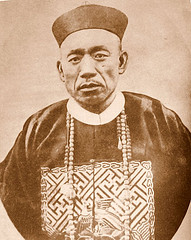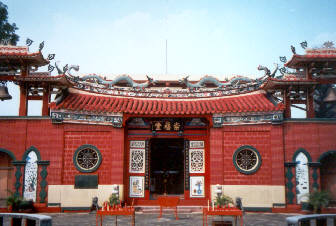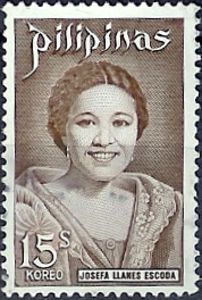Fabulous Philippines > Manila > Manila Chinese Cemetery
Share this page:
The 5.4 hectare Chinese cemetery, located in the suburb of Santa Cruz about 4 km north of Manila's Chinatown, is a town for the dead that comes with streets and ostentatious tombs built in the form of houses, villas or pagodas – some as high as two or more storeys.
In sections known popularly as Millionaires' Row and Little Beverley Hills, the great wealth, luxury and status of the "dearly departed" can be viewed in the houses or villas containing all the creature comforts they were accustomed to when they were still alive: hot and cold running water, furniture, chandeliers, flushing toilets, mailboxes, and even air conditioners.
These houses are often constructed from imported Italian marble. Outside there is often gardens and upstairs balconies.
Every Sunday and especially on All Saints Day (November 1), the local Chinese come to honour their dead. Lavish feasts are arranged and the relatives sit around the table playing mahjong games (an empty chair is left for the departed one). Food is offered and incense sticks and paper cuttings are burnt in front of small household altars adorned with portraits of the "departed" family member.
A plot in the Manila Chinese Cemetery can easily cost up to P50 million. This huge fee will, however, only secure a plot of land for a 25 year lease, after which another leasing fee must be paid for or the body will have to be moved to another place.
This Cemetery (like the palatial mansions in the Manila suburb of Forbes Park) is one of those places where you can clearly sense the difference between the lifestyle of the rich and that of the poor in the Philippines. On one hand the rich occupy mansions both in life and in death; on the other, the poor live in slums and each day for them is a struggle to survive.
The Chinese cemetery is definitely worth a visit. The live-in caretakers will offer to show you around for a fee.
History
Founded in the 19th century by Lim Ong and Tan Quien Sien (who was also known by the Spanish as Don Carlos Palanca), the Manila Chinese Cemetery is the Philippine capital's second oldest cemetery (after the La Loma Catholic Cemetery that was founded in 1884).

Tan Quien Sien (AKA Carlos Palanca)
During the Spanish colonial period the ecclesiastical authorities refused to allow non-Christian Chinese to be buried in Catholic cemeteries. So the civil authorities allocated the area (adjacent to La Loma Catholic Cemetery in Santa Cruz) that is now known as the Manila Chinese Cemetery for the burial of Chinese Buddhists, Confucians and Taoists and other non-Christian Chinese. Ironically, today many Chinese Christians are also buried in this cemetery.

The Chong Hock Tong Temple, located in the Manila Chinese Cemetery, is Manila's oldest existing Chinese temple
In the 1850s the Chong Hock Tong Temple was built in the cemetery. As most other Chinese temples built in earlier years were located in and around the suburb of Bindondo, and were destroyed during the Battle of Manila in 1945, the Chong Hock Tong Temple is now the oldest remaining Chinese temple in Manila.

1973 Philippines postage stamp depicting Josefa Llanes Escoda (1898-1945)
During World War II a number of prominent Filipinos were executed by the Japanese in the Manila Chinese Cemetery cemetery. These included:
-- Vicente Lim (Filipino Brigadier General and hero during World War II and a charter member of the Boy Scouts of the Philippines)
-- Josefa Llanes Escoda (founder of the Girl Scouts of the Philippines)
-- Rafael Roces (notable writer)
-- Manuel Arguilla (notable writer)
-- Virgilio Lobregat (athlete and guerilla fighter)
-- Yang Guangsheng (Chinese Consul-General)
The Liat See Tong Martyrs' Hall (also known as the Lee See Tong Martyrs' Hall) was built in the early 1960s in honor of a number of prominent Chinese community leaders who were executed by the Japanese shortly after the latter invaded the Philippines. Those martyrs included:
-- Dy Hoc Siu (the leader of the committee campaigning to boycott Japanese trade with the Philippines during World War II - this was part of the nationwide league opposing Japanese militarism, the "Khong Tiak Hue" [Resist the Enemy League])
-- Dy Hoc Khe (a relative of Dy Hoc Siu and another member of the anti-Japanese movement)
-- Yu Yi Tong (editor of the Chinese Commercial News)
Carlos Palanca (Tan Quien Sien) Memorial
This memorial is dedicated to the memory of Carlos Palanca (also known as Tan Quien Sien), the Chinese Filipino business and civic leader during the Spanish colonial period who founded the Manila Chinese Cemetery. The memorial is surmounted with a bust of Carlos Palanca.
Ruby Tower Memorial
This memorial is dedicated to Chinese-Filipinos who were among the 260 people who perished in the collapse of the six-storey Ruby Tower building in the Manila suburb of Binondo during the deadly "Casiguran" earthquake that hit the capital city on 2 August 1968.
Apolinario Mabini Pyramid
Apolinario Mabini (1864-1903), the Philippine Revolutionary leader, political philosopher, educator, lawyer and the first prime minister of the Philippines, was originally buried in this cemetery but later his remains were removed to his hometown of Batangas.
The site of Mabini's former grave in this cemetery is marked by a large stone pyramid. The pyramid is a symbol representing the Free Masons (Mabini was a Mason).
Notable burials
-- Vicente Lim (Filipino Brigadier General and hero during the Second World War and one of the charter members of the Boy Scouts of the Philippines)
-- Dee Cheng Chuan (founder of Chinabank, the first Chinese bank in the Philippines)
-- Ma Mon Luk (mami king)
Share this page:
Author: David Paul Wagner
(David Paul Wagner on Google+)
|


